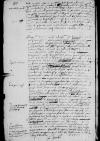List #1776
[Ioannes DANTISCUS] do [Seweryn BONER]Löbau (Lubawa), 1537-11-16
Rękopiśmienne podstawy źródłowe:
Pomocnicze podstawy źródłowe:
Publikacje:
| ||||||||||||||||
Tekst + aparat krytyczny + komentarzZwykły tekstTekst + komentarzTekst + aparat krytyczny
Magnifice Domine, amice carissime et honoran(de) or honoran(dissime)⌈honoran(de)honoran(de) or honoran(dissime)⌉. Salutem et successuum felicissimorum continuum precor superinscribed⌈precorprecor superinscribed⌉ Magnificentiae Vestrae precor profectum.
cf.
ms 1 pac[ti] paper damaged⌈pactims 2 3 4 pacti,
ms 1 pac[ti] paper damaged⌉, quod inivit superinscribed⌈inivitinivit superinscribed⌉ ratione coniugii cum
ms 1 m[a]rem paper damaged⌈maremms 2 3 4 marem,
ms 1 m[a]rem paper damaged⌉ pepererit, manebit superinscribed in place of crossed-out manet⌈manetmanebitmanebit superinscribed in place of crossed-out manet⌉ uxor, sin minus, soluta fu(erin)t iura matrimonii et vitae fortassis huius
miserae puerperae on the margin⌈et vitae fortassis huius
miserae puerperaeet vitae fortassis huius
miserae puerperae on the margin⌉, ducturus eadem condicione aliam atque aliam superinscribed⌈atque aliamatque aliam superinscribed⌉, quousque masculinum written over s⌈smm written over s⌉culinum adscribed⌈culinumculinum adscribed⌉ quiddam nascatur. Hanc legem, cum in
ms 1 sanx[it] paper damaged⌈sanxitms 2 3 4 sanxit,
ms 1 sanx[it] paper damaged⌉ libidinosis et impuris adulteris non ingratam. Porro ms 2 3 4 legislatorem,
ms 1 [le]gislatorem paper damaged⌈legislatoremms 2 3 4 legislatorem,
ms 1 [le]gislatorem paper damaged⌉ tot sceleribus et caedibus madentem ms 2 3 4 paulo post,
ms 1 pau[lo post] paper damaged⌈paulo postms 2 3 4 paulo post,
ms 1 pau[lo post] paper damaged⌉ Deus pro sua in omnes et omnia aequitate non impunitate paper damaged⌈[unitate]unitate paper damaged⌉ impunitate non donabit. De
ms 1 caes[are] paper damaged⌈caesarems 2 3 4 caesare,
ms 1 caes[are] paper damaged⌉ nostro
ms 1 [etiam] paper damaged⌈etiamms 2 3 4 etiam,
ms 1 [etiam] paper damaged⌉ de concilio Magnificentia Vestra habuerit, ut me ms 2 3 4 participem faciat,
ms 1 particip[em faciat] paper damaged⌈participem faciatms 2 3 4 participem faciat,
ms 1 particip[em faciat] paper damaged⌉, meque, qua cepit, benevolentia prosequi non desinat on the margin⌈meque, qua cepit, benevolentia prosequi non desinatmeque, qua cepit, benevolentia prosequi non desinat on the margin⌉, impense oro. Eandem Magnificentiam Vestram
ms 1 [quam diutissime] paper damaged⌈quam diutissimems 2 3 4 quam diutissime,
ms 1 [quam diutissime] paper damaged⌉ sospitet prosperetque in omnibus.
Ex
ms 1 Lubav[iensi] paper damaged⌈Lubaviensims 2 3 4 Lubaviensi,
ms 1 Lubav[iensi] paper damaged⌉
[1] As requested by Sigismund I, Dantiscus held negotiations with Otto Heinrich Wittelsbach in Cracow during the Diet of 1536/37 (cf. letter cf.
[3] The Act of Supremacy (1534) with which the English parliament legalized the split of the English church from Rome, at the same time making the king the supreme head of the newly established and independent Church of England.
[2] omnia? crossed out with a separate line, was probably meant to be linked to the sarta tecta that followed, to which, after omnia was crossed out, an abbreviation mark was doubtless added

 BCz, 244, p. 310
BCz, 244, p. 310